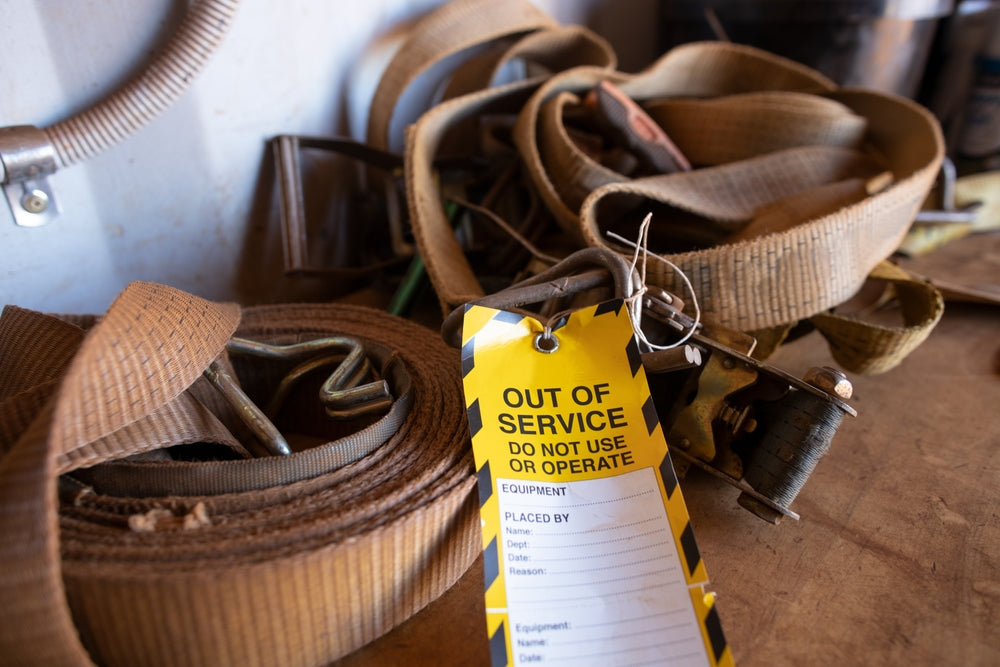At Bounding, we understand the importance of maintaining ratchet straps for ensuring safety and maximising their lifespan. Ratchet straps (also known as cargo straps, lashing straps or tie-down straps) are invaluable tools for securing cargo during transportation such as motorcycles and proper maintenance plays a crucial role in their effectiveness. In this comprehensive guide, we will provide you with practical guidance on maintaining ratchet straps, helping you ensure their longevity and optimal performance.
What is a ratchet strap?
They consist of a webbing material, typically made of durable polyester, and a ratcheting mechanism that allows for secure tightening and quick release. These can be paired with wear sleeves which protect the polyester webbing on sharp edges.
These heavy duty straps are designed to secure cargo by creating tension and preventing movement or shifting during transit. They come in various lengths (metres) and can also have a claw hook on one end and can come as an endless ratchet There are also smaller mini ratchet straps which have a smaller lashing capacity for smaller load capacity domestic use. A properly maintained ratchet tie-down strap will not only protect the cargo but also safeguard the safety of drivers and other road users.
UK Importance of Regular Inspection of Ratchet Straps

Regular inspection is a crucial step in maintaining ratchet straps. By carefully examining the straps, you can identify any signs of wear/damage before they escalate into safety hazards. Here's a step-by-step guide to conducting a thorough inspection:
1. Check Polyester Webbing
Inspect the webbing for any signs of fraying, cuts, or abrasions. Pay close attention to the areas near hooks or attachment points, as these are prone to stress and wear. If you notice any damage, it's essential to replace the strap to avoid compromising its strength.
2. Examine Ratcheting Mechanism
Inspect the ratcheting mechanism for any signs of corrosion, rust, or malfunction. Ensure that the handle moves smoothly and locks securely in place. If you notice any issues, lubricate the mechanism or consider replacing entirely.
3. Inspect Double J-Hooks and Attachments
Check the hooks and attachments for signs of damage or deformation. Ensure that the hooks are not bent or broken and that any locking mechanisms are functioning correctly. Replace any compromised hooks or attachments to maintain the integrity of the strap.
4. Review the Working Load Limit (WLL)
Every ratchet strap has a specified Working Load Limit (WLL), which indicates the maximum weight it can safely secure. Ensure that you are using ratchet straps with an appropriate WLL for your load. Exceeding the WLL can lead to failure and compromise safety.
Cleaning and Storage Recommendations

Proper cleaning and storage significantly contribute to the longevity of ratchet straps. By following these recommendations, you can help prevent damage and ensure their readiness for future use:
1. Remove Debris & Contaminants
After each use, remove any debris, or contaminants from the webbing. These substances can degrade the material over time and compromise strength. Use a soft brush or cloth to gently clean the webbing, and consider using mild soap if necessary. Rinse thoroughly and allow the to air dry before storage.
2. Avoid Excessive Heat/Sun Exposure
Prolonged exposure to extreme heat and sunlight can weaken the webbing material. Whenever possible, store in a cool, dry location away from direct sunlight. If you must transport or store them in a vehicle, consider using a protective cover to shield from excessive heat and UV rays.
3. Prevent Chemical Contact
Ratchet straps should be kept away from chemicals, solvents, oils, and acids, as these substances can degrade the webbing material. Store them in a dedicated area that is free from any potentially damaging substances.
4. Proper Lashing Coiling and Storage
When not in use, coil the ratchet straps neatly to prevent tangling and damage. Secure the coiled strap with a rubber band or a Velcro strap to maintain its compactness. Store them in a dry and clean environment, preferably in a storage bag or container specifically designed to hold them.
Safety Precautions and Best Practices

While maintaining ratchet straps is essential, it is equally important to follow safety precautions and adhere to best practices during their use. Here are some key considerations:
1. Proper Load Distribution
Ensure that the load is evenly distributed and properly secured as per UK laws. Uneven loading can cause excessive stress on specific points, leading to premature wear or failure. Use additional ratchet straps or support when necessary to distribute the load evenly.
2. Avoid Overloading
Always respect the Working Load Limit (WLL) specified by the manufacturer. Overloading significantly increases the risk of failure. If your cargo exceeds the WLL, consider using alternative securing methods or consult a professional for guidance.
3. Secure Attachment Points
Attach the hooks to strong and reliable anchor points on the vehicle or trailer. Ensure that the attachment points are free from any sharp edges or abrasive surfaces that may cause damage. Using corner protectors or edge guards can help prevent abrasion.
4. Regular Retightening
During transit, vibrations and movements can cause the straps to loosen. Periodically check and retighten the to maintain the desired tension and secure the load effectively. Regularly inspecting the straps throughout the journey is crucial for ensuring continued safety.
How to Identify Damaged or Worn Components?
Before you can replace a component, it is important to identify if it is damaged or worn. Properly identifying damaged or worn components is the first step in effective maintenance and replacement. By recognising signs of deterioration, you can address issues promptly and prevent further damage. Methods for checking condition:
Visual Inspection
Perform a thorough visual inspection of the component. Look for signs of cracks, corrosion, leakage, fraying, or any other visible damage. Pay attention to any irregularities or abnormalities that could indicate wear.
Listening for Abnormal Sounds
Listen carefully while the equipment is running. Unusual sounds such as squeaks, rattles, or grinding noises may indicate worn-out or faulty components. These sounds can help pinpoint the affected area.
Monitoring Performance
Keep track of the equipment's performance over time. Any decrease in efficiency, power, or accuracy could be a result of worn or damaged components. Monitor temperature, speed, pressure, or any other relevant performance metrics.
Conclusion
Maintaining ratchet straps is essential for their longevity and reliable performance. By conducting regular inspections, cleaning after use, storing them properly, and following safety precautions, you can maximise their lifespan and ensure safe transportation of your cargo.
Remember, the quality of ratchet straps directly affects the safety of your cargo and others on the road. By following the practical guidance provided in this guide, you are well on your way to maintaining ratchet straps effectively.
At Bounding, we are committed to providing high-quality ratchet straps and promoting safety in transportation. For any further inquiries or assistance, please feel free to reach out to our team of experts at hello@bounding.co.uk.


